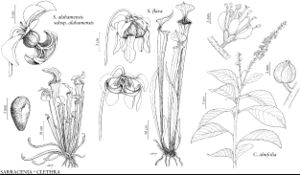Sarracenia alabamensis subsp. alabamensis
Plants forming dense clumps. Pitchers trimorphic (rarely dimorphic), spring pitchers decumbent or declined, usually sigmoidally curved (S-curved), yellow-green, often suffused with bronze to red, 18–50 cm, wings 0.5–1 cm wide, late spring pitchers erect, 18–50 cm, yellow-green, often suffused with bronze to red; orifice 0.7–2 cm wide, rim loosely revolute; summer pitchers erect, yellow-green, often strongly suffused with bronze to red (with noticeable small areas of faintly translucent tissue between veins proximal to orifice), larger and more robust than spring pitchers, not tapering gradually, bulging noticeably for several cm proximal to orifice, 19–72 cm, wings ca. 0.5 cm wide; orifice 0.7–6.7 cm diam., rim flared, juncture of rim and wing strongly indented, almost spoutlike; hoods of summer pitchers maroon to red-veined on adaxial proximal 1/2 or not distinctly colored, 0.8–9 × 0.8–8.8 cm, apiculum to 1 mm. Phyllodia typically absent, sometimes produced in late spring, erect to decumbent, oblanciform, 15–20 × 1–2 cm. Scapes 27–57 cm.
Phenology: Flowering Apr–May.
Habitat: Streamside and hillside seeps in meadows, thickets, and wooded slopes
Elevation: 50-200 m
Discussion
Of conservation concern.
Subspecies alabamensis is very rare; about 12 populations are known, all in the fall line sandhills of Autauga, Chilton, and Elmore counties, Alabama. It may be a relict in an area where, with modern fire suppression, suitable open habitats are maintained accidentally only by moderate cattle pasturing. It is federally listed as endangered and deserves managed protection. The subspecies is introduced in southeastern Virginia.
Sarracenia rubra Walter subsp. alabamensis (Case & R. B. Case) D. E. Schnell, which pertains here, is an illegitimate combination based on the invalid basionym S. alabamensis Case & R. B. Case (1975).
Selected References
None.
Lower Taxa
"winged" is not a number."variable" is not a number.

